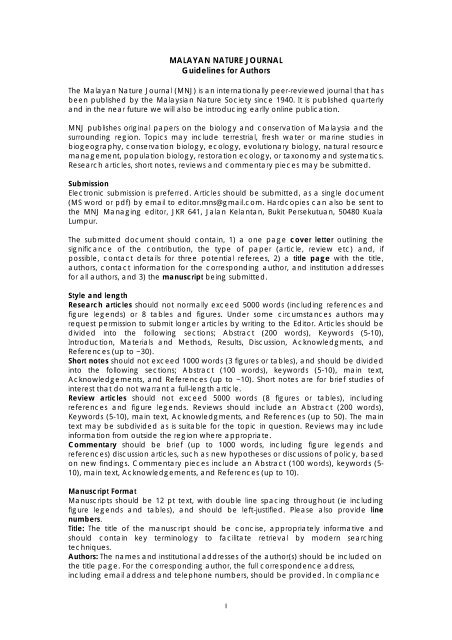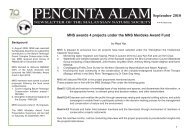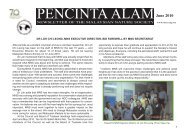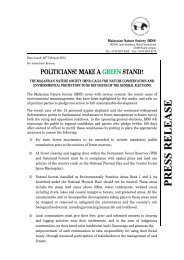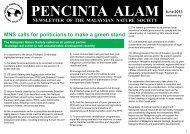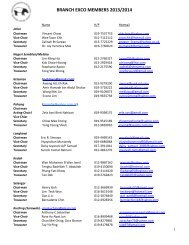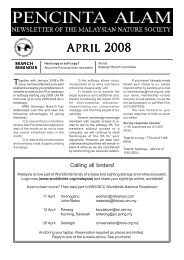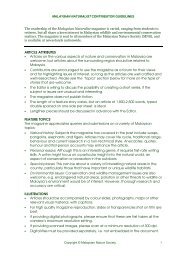MALAYAN NATURE JOURNAL Guidelines for Authors - Malaysian ...
MALAYAN NATURE JOURNAL Guidelines for Authors - Malaysian ...
MALAYAN NATURE JOURNAL Guidelines for Authors - Malaysian ...
You also want an ePaper? Increase the reach of your titles
YUMPU automatically turns print PDFs into web optimized ePapers that Google loves.
<strong>MALAYAN</strong> <strong>NATURE</strong> <strong>JOURNAL</strong><br />
<strong>Guidelines</strong> <strong>for</strong> <strong>Authors</strong><br />
The Malayan Nature Journal (MNJ) is an internationally peer-reviewed journal that has<br />
been published by the <strong>Malaysian</strong> Nature Society since 1940. It is published quarterly<br />
and in the near future we will also be introducing earlly online publication.<br />
MNJ publishes original papers on the biology and conservation of Malaysia and the<br />
surrounding region. Topics may include terrestrial, fresh water or marine studies in<br />
biogeography, conservation biology, ecology, evolutionary biology, natural resource<br />
management, population biology, restoration ecology, or taxonomy and systematics.<br />
Research articles, short notes, reviews and commentary pieces may be submitted.<br />
Submission<br />
Electronic submission is preferred. Articles should be submitted, as a single document<br />
(MS word or pdf) by email to editor.mns@gmail.com. Hardcopies can also be sent to<br />
the MNJ Managing editor, JKR 641, Jalan Kelantan, Bukit Persekutuan, 50480 Kuala<br />
Lumpur.<br />
The submitted document should contain, 1) a one page cover letter outlining the<br />
significance of the contribution, the type of paper (article, review etc) and, if<br />
possible, contact details <strong>for</strong> three potential referees, 2) a title page with the title,<br />
authors, contact in<strong>for</strong>mation <strong>for</strong> the corresponding author, and institution addresses<br />
<strong>for</strong> all authors, and 3) the manuscript being submitted.<br />
Style and length<br />
Research articles should not normally exceed 5000 words (including references and<br />
figure legends) or 8 tables and figures. Under some circumstances authors may<br />
request permission to submit longer articles by writing to the Editor. Articles should be<br />
divided into the following sections; Abstract (200 words), Keywords (5-10),<br />
Introduction, Materials and Methods, Results, Discussion, Acknowledgments, and<br />
References (up to ~30).<br />
Short notes should not exceed 1000 words (3 figures or tables), and should be divided<br />
into the following sections; Abstract (100 words), keywords (5-10), main text,<br />
Acknowledgements, and References (up to ~10). Short notes are <strong>for</strong> brief studies of<br />
interest that do not warrant a full-length article.<br />
Review articles should not exceed 5000 words (8 figures or tables), including<br />
references and figure legends. Reviews should include an Abstract (200 words),<br />
Keywords (5-10), main text, Acknowledgments, and References (up to 50). The main<br />
text may be subdivided as is suitable <strong>for</strong> the topic in question. Reviews may include<br />
in<strong>for</strong>mation from outside the region where appropriate.<br />
Commentary should be brief (up to 1000 words, including figure legends and<br />
references) discussion articles, such as new hypotheses or discussions of policy, based<br />
on new findings. Commentary pieces include an Abstract (100 words), keywords (5-<br />
10), main text, Acknowledgements, and References (up to 10).<br />
Manuscript Format<br />
Manuscripts should be 12 pt text, with double line spacing throughout (ie including<br />
figure legends and tables), and should be left-justified. Please also provide line<br />
numbers.<br />
Title: The title of the manuscript should be concise, appropriately in<strong>for</strong>mative and<br />
should contain key terminology to facilitate retrieval by modern searching<br />
techniques.<br />
<strong>Authors</strong>: The names and institutional addresses of the author(s) should be included on<br />
the title page. For the corresponding author, the full correspondence address,<br />
including email address and telephone numbers, should be provided. In compliance<br />
1
with normal ethical standards, all authors should have made a significant scientific<br />
contribution to the paper and have read the manuscript be<strong>for</strong>e it is submitted.<br />
Abstract and Key Words: The abstract should objectively describe the problem<br />
studied, why it was important to study, the most important findings and their<br />
significance.<br />
Place key words below the abstract. Supply 5-10 key words <strong>for</strong> indexing,<br />
including vernacular and scientific names of principal organisms, geographic area,<br />
phenomena and entities studied and methods. These should be chosen to facilitate<br />
retrieval by modern searching techniques and should not include words already<br />
mentioned in the Title.<br />
Citations and References: Text citations should give the author’s name and year of<br />
publication (Wong 1992). One or two authors are cited as (Wong and Ong 1992)<br />
while more than two are cited as (Wong et al. 1992). Multiple citations are separated<br />
by commas and listed chronological order. Avoid over referencing.<br />
In preparing the Reference section, contributors should include authors’<br />
names, year of publication, title of article, name of publication in full, volume number<br />
and inclusive pages <strong>for</strong> chapters of books or journal articles. References should be<br />
listed in alphabetical order.<br />
<br />
<br />
<br />
<br />
<br />
<br />
<br />
<br />
<br />
<strong>Authors</strong> are particularly urged to ensure that citations and<br />
bibliographic details are accurate. Correct references are the responsibility of<br />
the author.<br />
Tables: Tables should be stand alone (i.e. the reader should understand the<br />
content of the table without reference to the text) and referenced in the text.<br />
Each table should be started on a separate page, and these should be<br />
grouped at the end of the manuscript. Tables should be arranged with<br />
regards to the dimensions of the print area of the page (13 x 20cm).<br />
Each table should be numbered with Arabic numerals and<br />
accompanied by a title (e.g. Table 1: The number of species …) .<br />
Figures: Figures should be clearly drawn and saved as raster graphics<br />
(bitmap, tiff, png, eps), not vector graphics (e.g. Jpeg), at a minimum of 300<br />
dpi. Photographs should preferable be saved at 600 dpi. Figures should be<br />
submitted embedded in the manuscript. Drawings should be planned to<br />
stand 50% reduction. Please use scale-bars rather than quoting magnification,<br />
as these will be affected by the amount of reduction. Please keep the<br />
manuscript file size to
and should be stand-alone (i.e. a reader should be able to understand the<br />
figure without reference to the main text).<br />
The cost of COLOUR figures must be borne by the author. Acceptance<br />
of such illustrations is at the discretion of the Hon. Editor.<br />
Once a paper has been accepted <strong>for</strong> publication the authors will be<br />
asked to submit the original figures as separate digital files or original drawings<br />
or slides.<br />
Species names<br />
On first mention of a species name family and if appropriate higher<br />
taxonomic levels should be give in parenthesis after the name. It is the<br />
responsibility of the author to ensure that all names follow current taxonomy. If<br />
there has been a recent change of name the old name may be given in<br />
parenthesis where appropriate.<br />
If common English or local names are used the scientific name should<br />
be given in parenthesis on first mention. The use of common names is<br />
discouraged and would only be appropriate in the case of well-known<br />
species.<br />
Numbers and Measurement Units<br />
The metric system and SI units should be used. In the text, numbers from one<br />
to ten should be spelled in full and numbers of 11 or more should be written in<br />
as numerals: thus, two days but 11 leaves. Numbers preceding units should be<br />
written as numerals; thus: 8 cm and 7-10 mm.<br />
For other parameters of style, authors may consult the Chicago Manual of<br />
Style or a current issue of the Malayan Nature Journal.<br />
Review process and Proofs<br />
It is our target to reduce submission-to-decision time to two months. The initial<br />
review should take one month or less. Once a revision is requested, authors<br />
should note that if a manuscript is not revised and returned to MNJ within 8<br />
weeks <strong>for</strong> a full length article or 4 weeks <strong>for</strong> short articles, it will be treated as a<br />
new manuscript and will be subject to the full review process.<br />
In their own interest, authors should retain a complete copy of the<br />
manuscript identical in every respect to the material submitted. MNS bears no<br />
responsibility <strong>for</strong> material that may be lost.<br />
<strong>Authors</strong> will receive proofs of their papers be<strong>for</strong>e publication. These should be<br />
corrected (not revised) and returned to the editor within 2 weeks.<br />
Reprints<br />
<strong>Authors</strong> will receive a pdf copy of their article, which they may distribute<br />
under the restrictions of “Fair use of Copyright”. We suggest this means putting<br />
on a personal website or sending out to people who write in requesting<br />
reprints. Mass online distribution, however, is not permitted. Twenty-five<br />
hardcopy reprints are supplied free and the authors may order more in<br />
advance by writing to the managing editor, the additional cost of which is<br />
borne by the authors.<br />
3


